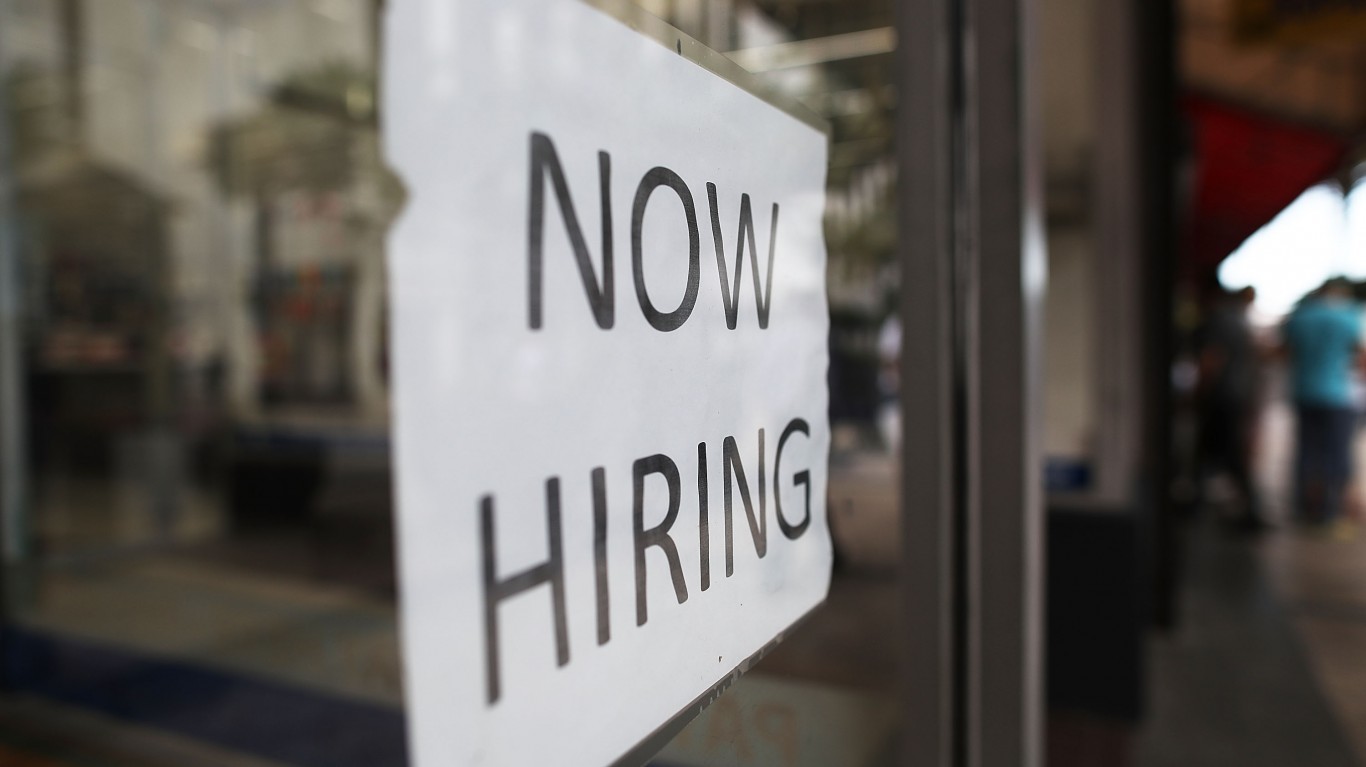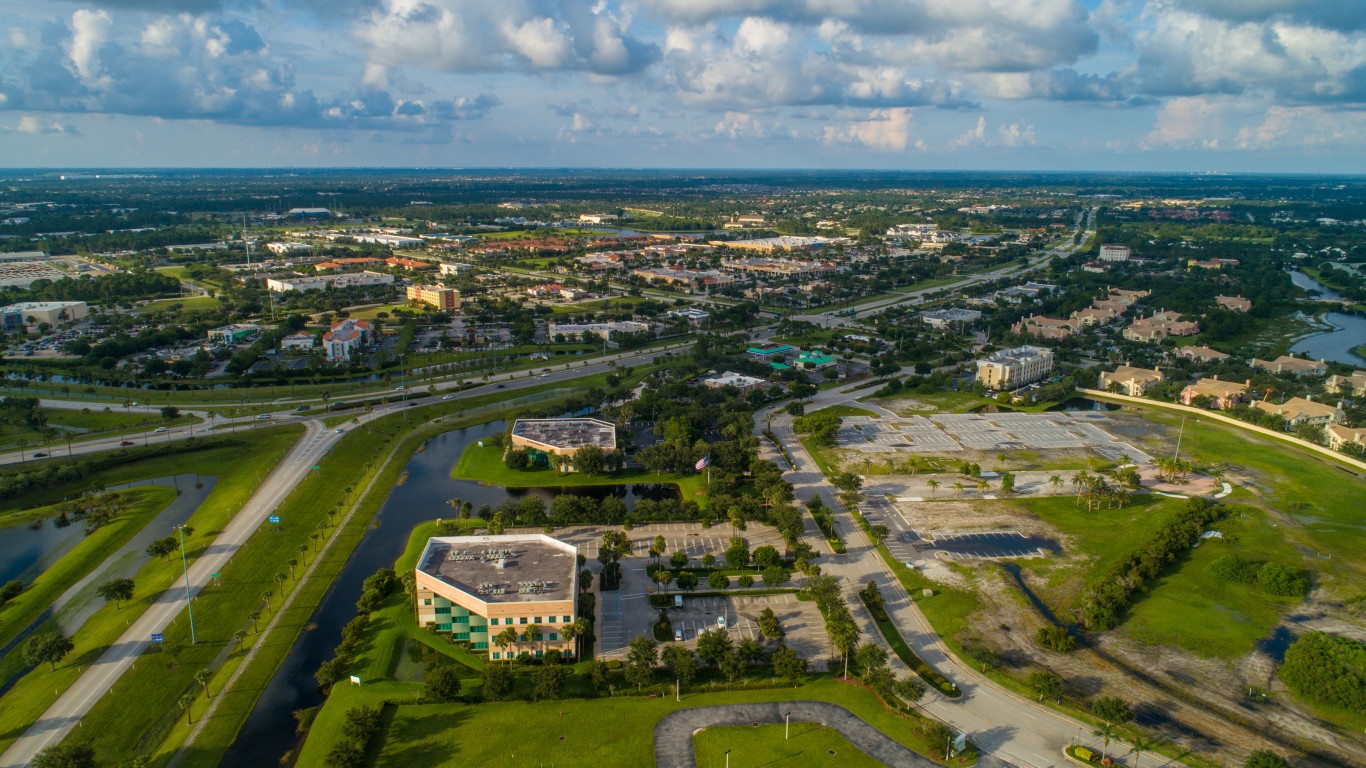
Despite soaring inflation, the U.S. economy continues to benefit from strong job growth as it continues to recover from the COVID-19 pandemic. Still, many companies and businesses are struggling to find and hire workers, as the number of unfilled jobs has hit multi-decade highs in recent months. There were over 11.5 million job openings nationwide at the end of March 2022, an all-time high, and 36% more than the same month last year.
Causes of the historic labor shortage vary. During the pandemic, early retirements surged, parents of school-age children left the workforce en masse, and immigration slowed considerably – resulting in millions of fewer workers than there otherwise would have been. This is what it costs to retire comfortably in each state.
Today, the labor force participation rate – the share of Americans 16 and older either working or looking for work – stands at 62.2%, a low not seen in the pre-pandemic United States since the 1970s. The national labor shortage is putting a strain on businesses across the country, forcing some to reduce hours and others to close completely.
Using data from the Bureau of Labor Statistics, 24/7 Wall St. identified the states with the most job openings. States are ranked by the share of all jobs that were unfilled as of the end of March 2022, the most recent month of available data. Depending on the state, the share of jobs that remain unfilled ranges from 6.0% to 9.8%. For context, 7.1% of jobs nationwide are unfilled.
Despite the need for workers, a small percentage of the labor force remains unemployed, suggesting that among the unemployed there is a mismatch between either the skills employers are seeking and the labor pool or the kind of work or benefits job seekers desire and what employers offer. The national unemployment rate was 3.6% in March 2022. Depending on the state, unemployment ranges from 2.0% to 5.3%. Here is a look at the industry laying off the most Americans.
Click here to see the states with the most job openings
Click here to read our detailed methodology

50. New York
> Job openings at the end of March 2022: 6.0% of all jobs (594,000 total openings)
> March 2022 unemployment: 4.6%
> 1-year change in job openings: +46.3% (188,000 more openings)
> Labor force size: 9,376,546 people
[in-text-ad]

49. Kansas
> Job openings at the end of March 2022: 6.3% of all jobs (93,000 total openings)
> March 2022 unemployment: 2.5%
> 1-year change in job openings: +13.4% (11,000 more openings)
> Labor force size: 1,499,603 people
48. Connecticut
> Job openings at the end of March 2022: 6.3% of all jobs (110,000 total openings)
> March 2022 unemployment: 4.6%
> 1-year change in job openings: +20.9% (19,000 more openings)
> Labor force size: 1,879,419 people

47. New Jersey
> Job openings at the end of March 2022: 6.5% of all jobs (290,000 total openings)
> March 2022 unemployment: 4.2%
> 1-year change in job openings: -0.7% (2,000 fewer openings)
> Labor force size: 4,618,709 people
[in-text-ad-2]
46. Pennsylvania
> Job openings at the end of March 2022: 6.5% of all jobs (411,000 total openings)
> March 2022 unemployment: 4.9%
> 1-year change in job openings: +6.8% (26,000 more openings)
> Labor force size: 6,387,365 people

45. Iowa
> Job openings at the end of March 2022: 6.6% of all jobs (111,000 total openings)
> March 2022 unemployment: 3.3%
> 1-year change in job openings: +30.6% (26,000 more openings)
> Labor force size: 1,692,502 people
[in-text-ad]

44. Alabama
> Job openings at the end of March 2022: 6.6% of all jobs (147,000 total openings)
> March 2022 unemployment: 2.9%
> 1-year change in job openings: +33.6% (37,000 more openings)
> Labor force size: 2,270,463 people

43. South Dakota
> Job openings at the end of March 2022: 6.7% of all jobs (32,000 total openings)
> March 2022 unemployment: 2.5%
> 1-year change in job openings: +23.1% (6,000 more openings)
> Labor force size: 472,658 people

42. Nebraska
> Job openings at the end of March 2022: 6.7% of all jobs (74,000 total openings)
> March 2022 unemployment: 2.0%
> 1-year change in job openings: +23.3% (14,000 more openings)
> Labor force size: 1,058,891 people
[in-text-ad-2]

41. Washington
> Job openings at the end of March 2022: 6.7% of all jobs (250,000 total openings)
> March 2022 unemployment: 4.2%
> 1-year change in job openings: +35.9% (66,000 more openings)
> Labor force size: 4,003,490 people

40. Ohio
> Job openings at the end of March 2022: 6.7% of all jobs (393,000 total openings)
> March 2022 unemployment: 4.1%
> 1-year change in job openings: +37.4% (107,000 more openings)
> Labor force size: 5,763,448 people
[in-text-ad]
39. North Dakota
> Job openings at the end of March 2022: 6.8% of all jobs (31,000 total openings)
> March 2022 unemployment: 2.9%
> 1-year change in job openings: +34.8% (8,000 more openings)
> Labor force size: 409,949 people

38. California
> Job openings at the end of March 2022: 6.8% of all jobs (1,279,000 total openings)
> March 2022 unemployment: 4.9%
> 1-year change in job openings: +64.2% (500,000 more openings)
> Labor force size: 19,131,273 people

37. Delaware
> Job openings at the end of March 2022: 6.9% of all jobs (34,000 total openings)
> March 2022 unemployment: 4.5%
> 1-year change in job openings: +41.7% (10,000 more openings)
> Labor force size: 498,638 people
[in-text-ad-2]

36. Maine
> Job openings at the end of March 2022: 6.9% of all jobs (47,000 total openings)
> March 2022 unemployment: 3.6%
> 1-year change in job openings: +14.6% (6,000 more openings)
> Labor force size: 679,433 people

35. Wisconsin
> Job openings at the end of March 2022: 6.9% of all jobs (218,000 total openings)
> March 2022 unemployment: 2.8%
> 1-year change in job openings: +22.5% (40,000 more openings)
> Labor force size: 3,144,673 people
[in-text-ad]

34. Texas
> Job openings at the end of March 2022: 6.9% of all jobs (985,000 total openings)
> March 2022 unemployment: 4.4%
> 1-year change in job openings: +38.3% (273,000 more openings)
> Labor force size: 14,414,591 people

33. New Hampshire
> Job openings at the end of March 2022: 7.0% of all jobs (51,000 total openings)
> March 2022 unemployment: 2.5%
> 1-year change in job openings: +8.5% (4,000 more openings)
> Labor force size: 758,616 people

32. Utah
> Job openings at the end of March 2022: 7.1% of all jobs (127,000 total openings)
> March 2022 unemployment: 2.0%
> 1-year change in job openings: +51.2% (43,000 more openings)
> Labor force size: 1,705,513 people
[in-text-ad-2]

31. Colorado
> Job openings at the end of March 2022: 7.1% of all jobs (215,000 total openings)
> March 2022 unemployment: 3.7%
> 1-year change in job openings: +42.4% (64,000 more openings)
> Labor force size: 3,211,692 people

30. Indiana
> Job openings at the end of March 2022: 7.1% of all jobs (241,000 total openings)
> March 2022 unemployment: 2.2%
> 1-year change in job openings: +37.7% (66,000 more openings)
> Labor force size: 3,332,239 people
[in-text-ad]

29. Wyoming
> Job openings at the end of March 2022: 7.2% of all jobs (22,000 total openings)
> March 2022 unemployment: 3.4%
> 1-year change in job openings: +15.8% (3,000 more openings)
> Labor force size: 290,365 people

28. Idaho
> Job openings at the end of March 2022: 7.2% of all jobs (63,000 total openings)
> March 2022 unemployment: 2.7%
> 1-year change in job openings: +14.5% (8,000 more openings)
> Labor force size: 932,278 people

27. Missouri
> Job openings at the end of March 2022: 7.2% of all jobs (225,000 total openings)
> March 2022 unemployment: 3.6%
> 1-year change in job openings: +40.6% (65,000 more openings)
> Labor force size: 3,087,759 people
[in-text-ad-2]

26. Virginia
> Job openings at the end of March 2022: 7.2% of all jobs (310,000 total openings)
> March 2022 unemployment: 3.0%
> 1-year change in job openings: +39.0% (87,000 more openings)
> Labor force size: 4,311,629 people

25. Illinois
> Job openings at the end of March 2022: 7.2% of all jobs (468,000 total openings)
> March 2022 unemployment: 4.7%
> 1-year change in job openings: +47.6% (151,000 more openings)
> Labor force size: 6,430,758 people
[in-text-ad]

24. Nevada
> Job openings at the end of March 2022: 7.3% of all jobs (114,000 total openings)
> March 2022 unemployment: 5.0%
> 1-year change in job openings: +14.0% (14,000 more openings)
> Labor force size: 1,503,263 people

23. Louisiana
> Job openings at the end of March 2022: 7.3% of all jobs (149,000 total openings)
> March 2022 unemployment: 4.2%
> 1-year change in job openings: +43.3% (45,000 more openings)
> Labor force size: 2,089,731 people

22. Tennessee
> Job openings at the end of March 2022: 7.3% of all jobs (252,000 total openings)
> March 2022 unemployment: 3.2%
> 1-year change in job openings: +32.6% (62,000 more openings)
> Labor force size: 3,370,618 people
[in-text-ad-2]

21. Michigan
> Job openings at the end of March 2022: 7.3% of all jobs (339,000 total openings)
> March 2022 unemployment: 4.4%
> 1-year change in job openings: +29.9% (78,000 more openings)
> Labor force size: 4,819,131 people

20. New Mexico
> Job openings at the end of March 2022: 7.5% of all jobs (69,000 total openings)
> March 2022 unemployment: 5.3%
> 1-year change in job openings: +32.7% (17,000 more openings)
> Labor force size: 948,386 people
[in-text-ad]

19. Arizona
> Job openings at the end of March 2022: 7.5% of all jobs (247,000 total openings)
> March 2022 unemployment: 3.3%
> 1-year change in job openings: +36.5% (66,000 more openings)
> Labor force size: 3,548,773 people

18. Florida
> Job openings at the end of March 2022: 7.5% of all jobs (749,000 total openings)
> March 2022 unemployment: 3.2%
> 1-year change in job openings: +75.8% (323,000 more openings)
> Labor force size: 10,513,164 people

17. Mississippi
> Job openings at the end of March 2022: 7.6% of all jobs (95,000 total openings)
> March 2022 unemployment: 4.2%
> 1-year change in job openings: +23.4% (18,000 more openings)
> Labor force size: 1,259,602 people
[in-text-ad-2]

16. Oregon
> Job openings at the end of March 2022: 7.6% of all jobs (160,000 total openings)
> March 2022 unemployment: 3.8%
> 1-year change in job openings: +28.0% (35,000 more openings)
> Labor force size: 2,184,140 people

15. Maryland
> Job openings at the end of March 2022: 7.6% of all jobs (223,000 total openings)
> March 2022 unemployment: 4.6%
> 1-year change in job openings: +11.5% (23,000 more openings)
> Labor force size: 3,198,116 people
[in-text-ad]

14. Vermont
> Job openings at the end of March 2022: 7.7% of all jobs (25,000 total openings)
> March 2022 unemployment: 2.7%
> 1-year change in job openings: +31.6% (6,000 more openings)
> Labor force size: 331,412 people

13. Rhode Island
> Job openings at the end of March 2022: 7.7% of all jobs (41,000 total openings)
> March 2022 unemployment: 3.4%
> 1-year change in job openings: +41.4% (12,000 more openings)
> Labor force size: 568,879 people

12. Arkansas
> Job openings at the end of March 2022: 7.8% of all jobs (111,000 total openings)
> March 2022 unemployment: 3.1%
> 1-year change in job openings: +40.5% (32,000 more openings)
> Labor force size: 1,343,907 people
[in-text-ad-2]

11. Minnesota
> Job openings at the end of March 2022: 7.8% of all jobs (245,000 total openings)
> March 2022 unemployment: 2.5%
> 1-year change in job openings: +88.5% (115,000 more openings)
> Labor force size: 3,071,594 people

10. Georgia
> Job openings at the end of March 2022: 7.8% of all jobs (402,000 total openings)
> March 2022 unemployment: 3.1%
> 1-year change in job openings: +39.1% (113,000 more openings)
> Labor force size: 5,251,130 people
[in-text-ad]

9. West Virginia
> Job openings at the end of March 2022: 7.9% of all jobs (60,000 total openings)
> March 2022 unemployment: 3.7%
> 1-year change in job openings: +20.0% (10,000 more openings)
> Labor force size: 794,175 people

8. South Carolina
> Job openings at the end of March 2022: 7.9% of all jobs (189,000 total openings)
> March 2022 unemployment: 3.4%
> 1-year change in job openings: +37.0% (51,000 more openings)
> Labor force size: 2,384,364 people

7. North Carolina
> Job openings at the end of March 2022: 7.9% of all jobs (406,000 total openings)
> March 2022 unemployment: 3.5%
> 1-year change in job openings: +36.7% (109,000 more openings)
> Labor force size: 5,030,542 people
[in-text-ad-2]

6. Montana
> Job openings at the end of March 2022: 8.0% of all jobs (44,000 total openings)
> March 2022 unemployment: 2.3%
> 1-year change in job openings: +25.7% (9,000 more openings)
> Labor force size: 558,466 people

5. Hawaii
> Job openings at the end of March 2022: 8.0% of all jobs (52,000 total openings)
> March 2022 unemployment: 4.1%
> 1-year change in job openings: +92.6% (25,000 more openings)
> Labor force size: 672,576 people
[in-text-ad]

4. Oklahoma
> Job openings at the end of March 2022: 8.0% of all jobs (146,000 total openings)
> March 2022 unemployment: 2.7%
> 1-year change in job openings: +40.4% (42,000 more openings)
> Labor force size: 1,862,120 people

3. Massachusetts
> Job openings at the end of March 2022: 8.0% of all jobs (318,000 total openings)
> March 2022 unemployment: 4.3%
> 1-year change in job openings: +48.6% (104,000 more openings)
> Labor force size: 3,775,288 people

2. Alaska
> Job openings at the end of March 2022: 9.2% of all jobs (32,000 total openings)
> March 2022 unemployment: 5.0%
> 1-year change in job openings: +23.1% (6,000 more openings)
> Labor force size: 361,758 people
[in-text-ad-2]

1. Kentucky
> Job openings at the end of March 2022: 9.8% of all jobs (210,000 total openings)
> March 2022 unemployment: 4.0%
> 1-year change in job openings: +87.5% (98,000 more openings)
> Labor force size: 2,060,065 people
Methodology
To determine the states with the most job openings, 24/7 Wall St. reviewed the Job Openings and Labor Turnover Survey report from the Bureau of Labor Statistics. States are ranked by the job openings rate, which is calculated by dividing the number of job openings by the sum of employment and job openings and multiplying the quotient by 100. For multiple states with the same job openings rate, ties were broken by the actual number of job openings.
Job openings are the number of positions – full-time, part-time, seasonal, short-term, or permanent – open on the last business day of March 2022, the most recent month of available data. In order to be counted as open, a job has to start within 30 days of when the employer can find a suitable candidate.
Figures on unemployment and labor force size, which includes Americans either working or actively looking for work, are also from the BLS.
Is Your Money Earning the Best Possible Rate? (Sponsor)
Let’s face it: If your money is just sitting in a checking account, you’re losing value every single day. With most checking accounts offering little to no interest, the cash you worked so hard to save is gradually being eroded by inflation.
However, by moving that money into a high-yield savings account, you can put your cash to work, growing steadily with little to no effort on your part. In just a few clicks, you can set up a high-yield savings account and start earning interest immediately.
There are plenty of reputable banks and online platforms that offer competitive rates, and many of them come with zero fees and no minimum balance requirements. Click here to see if you’re earning the best possible rate on your money!
Thank you for reading! Have some feedback for us?
Contact the 24/7 Wall St. editorial team.
 24/7 Wall St.
24/7 Wall St.


 24/7 Wall St.
24/7 Wall St. 24/7 Wall St.
24/7 Wall St. 24/7 Wall St.
24/7 Wall St.
